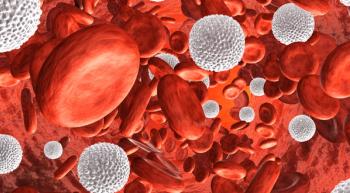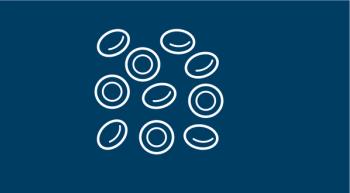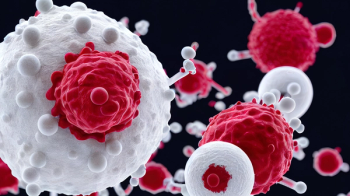
D-VRd After Maintenance Boosts MRD-Negativity Rates in Multiple Myeloma Subset
Rates of MRD negativity increased with daratumumab plus VRd in newly diagnosed, transplant-eligible multiple myeloma.
Treatment with daratumumab (Darzalex) plus bortezomib (Velcade), lenalidomide (Revlimid), and dexamethasone (D-VRd), followed by maintenance daratumumab plus lenalidomide (D-R), improved minimal residual disease (MRD) negativity rates compared with VRd, followed by lenalidomide maintenance, in newly diagnosed, transplant-eligible multiple myeloma, according to data from the phase 3 PERSEUS trial (NCT03710603).1
Findings presented at the 2024 ASCO Annual Meeting showed that 47.3% of patients treated in the D-VRd arm (n = 355) experienced MRD negativity at a 10-6 sensitivity for 12 months or more compared with 18.6% of patients in the VRd arm (n = 354). At a 10-5 sensitivity, these rates were 64.8% and 29.7%, respectively. Additionally, MRD negativity at a 10-6 sensitivity was sustained for at least 18 months in 42.0% of patients given D-VRd vs 15.0% of those treated with VRd. At a 10-5 sensitivity, these respective rates were 59.4% and 25.1%.
“The potential for a cure in newly diagnosed multiple myeloma is predicated on reaching sustained MRD negativity at 10-6 [sensitivity],” lead study author Paula Rodriguez-Otero, MD, PhD, of the Department of Hematology at Cancer Center Clínica Universidad de Navarra in Pamplona, Spain, said in a presentation of the data.
In January 2024, the FDA received a supplemental biologics license application seeking the approval of daratumumab and hyaluronidase-fihj (Darzalex Faspro) in combination with VRd as induction and consolidation therapy, followed by D-R maintenance, for the treatment of adult patients with newly diagnosed multiple myeloma who are eligible for autologous stem cell transplant (ASCT). The application was supported by prior data from PERSEUS.3
PERSEUS enrolled patients between 18 and 70 years of age with newly diagnosed multiple myeloma who were eligible for ASCT. An ECOG performance status of 0 to 2 was required.1
Patients were randomly assigned 1:1 to the D-VRd and VRd arms, where treatment was given in 28-day cycles. Patients in both arms underwent ASCT at the end of induction therapy. In the experimental arm, 4 cycles of induction therapy consisted of 1800 mg of subcutaneous daratumumab given once weekly in cycles 1 and 2, then once every 2 weeks in cycles 3 and 4; 1.3 mg/m2 of subcutaneous bortezomib on days 1, 4, 8, and 11 of each cycle; 25 mg of oral lenalidomide per day on days 1 to 21 of each cycle; and 40 mg of oral or intravenous dexamethasone on days 1 to 4 and 9 to 12 of each cycle. Two cycles of consolidation therapy included 1800 mg of daratumumab once every 2 weeks plus the same dosing regimen of VRd. During maintenance, 1800 mg of daratumumab was given once every 4 weeks in combination with 10 mg of lenalidomide per day.
After at least 2 years of maintenance, patients who were MRD-positive continued D-R until disease progression; patients who were MRD-negative with a complete response (CR) or better and at least 12 months of sustained MRD negativity (10-6 sensitivity) stopped daratumumab and continued lenalidomide. However, patients restarted daratumumab treatment if they lost CR without disease progression or experienced a recurrence of MRD.
In the control arm, patients received the same dosing schedule of VRd during induction and consolidation. Maintenance consisted of 10 mg of lenalidomide once per day until disease progression.
PFS served as the trial’s primary end point. Key secondary end points included CR or better rate, overall MRD-negativity rate, and overall survival.
Additional data showed that responses deepened over time in both arms with a higher rate of improvement in the D-VRd group. In the experimental arm, the CR or better rates at the end of induction, at the end of ASCT, at the end of consolidation, and overall were 22.5%, 27.9%, 44.5%, and 87.9%, respectively. These respective rates in the VRd arm were 21.2%, 23.4%, 34.7%, and 70.1%.
Furthermore, rates of MRD negativity deepened over time from the start of treatment, with a greater increase observed in the experimental arm. At a 10-6 sensitivity, the MRD-negative rates in the D-VRd arm at the end of consolidation, up to 12 months, up to 24 months, and up to 36 months were 34.4%, 43.9%, 57.7%, and 63.9%, respectively. These respective rates were 16.1%, 20.9%, 27.4%, and 30.8% for the VRd arm.
At a 10-5 sensitivity, the MRD-negative rates for the D-VRd arm were 57.5% at the end of consolidation, 65.1% at up to 12 months, 72.1% at up to 24 months, and 74.6% at up to 36 months. In the VRd arm, these rates were 32.5%, 38.7%, 44.9%, and 46.9%, respectively.
Notably, D-VRd improved MRD-negativity rates and sustained MRD-negativity rates across all prespecified subgroups. In patients with high-risk disease, those treated with D-VRd (n = 76) achieved an MRD-negativity rate at a 10-6 sensitivity of 57.9% compared with 30.8% for those given VRd (n = 78). These respective rates at a 10-5 sensitivity were 68.4% and 47.4%. In the experimental arm, 30.3% of high-risk patients sustained MRD negativity for at least 12 months at a 10-6 sensitivity vs 14.1% of those in the VRd arm. These rates at a 10-5 sensitivity were 48.7% and 25.6%, respectively. PFS was improved with D-VRd among patients with high-risk disease who achieved MRD negativity (HR, 0.62; 95% CI, 0.21-1.84; P = .3853).
During maintenance, 56.7% of patients in the D-VRd arm who were MRD-positive at a 10-6 sensitivity (n = 134) became MRD-negative compared with 25.2% of patients in the VRd arm (n =155; P <.0001). At a 10-5 sensitivity, 60.2% of patients in the D-VRd arm who were MRD-positive (n = 88) converted to MRD-negative vs 40.5% of patients in the VRd arm (n = 121; P = .0049).
In patients who became MRD-negative at a 10-6 sensitivity during maintenance, 31.3% of patients in the experimental arm sustained MRD negativity compared with 10.3% of patients in the control arm (P <.0001) at a 10-5 sensitivity, these rates were 38.6% and 17.4%, respectively (P = .0006).
Disclosures: Dr Rodriguez-Ortero reported serving in a consulting or advisory role for Abbvie, Bristol Myers Squibb, GlaxoSmithKline, Janssen, Pfizer, Roche, and Sanofi; being a member of a speakers’ bureau for Bristol Myers Squibb, GlaxoSmithKline, Janssen, Regeneron, and Sanofi; and receiving travel expenses from Pfizer.
References
- Rodriguez-Otero P, Moreau P, Dimopoulos MA, et al. Daratumumab (DARA) + bortezomib/lenalidomide/dexamethasone (VRd) in transplant-eligible (TE) patients (pts) with newly diagnosed multiple myeloma (NDMM): Analysis of minimal residual disease (MRD) in the PERSEUS trial. J Clin Oncol. 2024;42(suppl 16):7502. doi:10.1200/JCO.2024.42.16_suppl.7502
- Sonneveld P, Dimopoulos MA, Boccadoro M, et al. Daratumumab, bortezomib, lenalidomide, and dexamethasone for multiple myeloma. N Engl J Med. 2024;390(4):301-313. doi:10.1056/NEJMoa2312054
- Johnson & Johnson submits supplemental biologics license application to U.S. FDA seeking approval of Darzalex Faspro (daratumumab and hyaluronidase-fihj)-based regimen for the treatment of patients with transplant-eligible, newly diagnosed multiple myeloma. News release. Johnson & Johnson. January 30, 2024. Accessed June 3, 2024. https://www.jnj.com/media-center/press-releases/johnson-johnson-submits-supplemental-biologics-license-application-to-u-s-fda-seeking-approval-of-darzalex-faspro-daratumumab-and-hyaluronidase-fihj-based-regimen-for-the-treatment-of-patients-with-transplant-eligible-newly-diagnosed-multiple-myeloma
Newsletter
Knowledge is power. Don’t miss the most recent breakthroughs in cancer care.
















































































